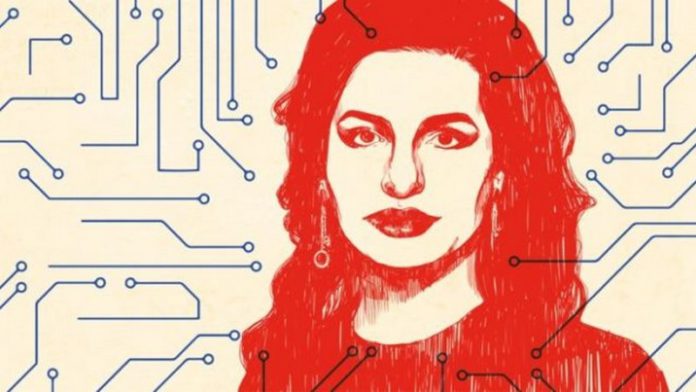Ruja Ignatova called herself the Cryptoqueen. She told people she had invented a cryptocurrency to rival Bitcoin, and persuaded them to invest billions. Then, two years ago, she disappeared. Jamie Bartlett spent months investigating how she did it for the Missing Cryptoqueen podcast, and trying to figure out where she’s hiding.
In early June 2016 a 36-year-old businesswoman called Dr Ruja Ignatova walked on stage at Wembley Arena in front of thousands of adoring fans. She was dressed, as usual, in an expensive ballgown, wearing long diamond earrings and bright red lipstick.
She told the cheering crowd that OneCoin was on course to become the world’s biggest cryptocurrency “for everyone to make payments everywhere”.
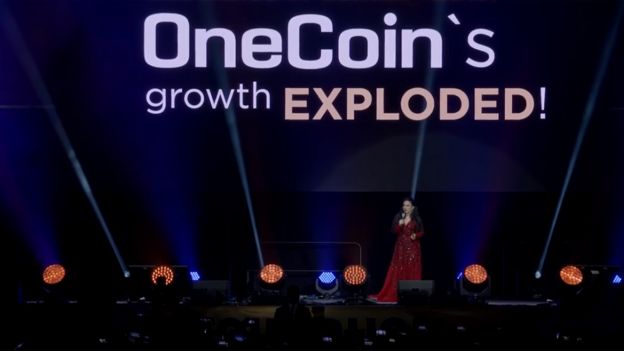
Dr Ruja speaking at the Wembley Arena
Bitcoin was the first cryptocurrency and is still the biggest and best-known – its rise in value from a few cents to hundreds of dollars per coin by mid-2016 had given rise to a frenzy of excitement among investors. Cryptocurrency as an idea was just entering the mainstream. Lots of people were looking to get involved in this strange new opportunity.
OneCoin, Dr Ruja told the Wembley audience, was the “Bitcoin Killer”. “In two years, nobody will speak about Bitcoin any more!” she shouted.
All over the world, people were already investing their savings into OneCoin, hoping to be part of this new revolution. Documents leaked to the BBC show that British people spent almost €30m on OneCoin in the first six months of 2016, €2m of it in a single week – and the rate of investment could have increased after the Wembley extravaganza. Between August 2014 and March 2017 more than €4bn was invested in dozens of countries. From Pakistan to Brazil, from Hong Kong to Norway, from Canada to Yemen… even Palestine.
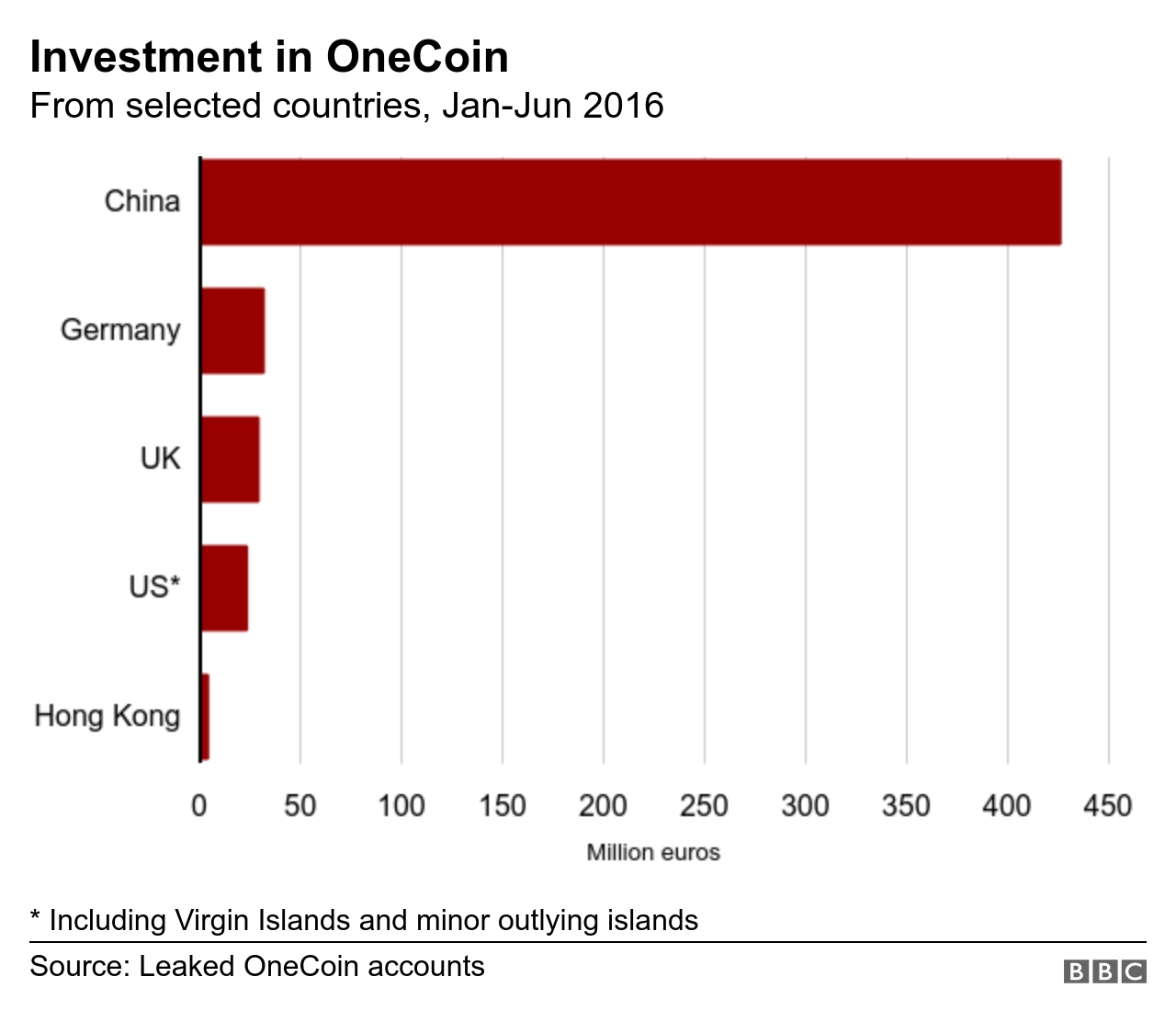
But there was something very important these investors didn’t know.
To explain this, I need first to explain briefly how a cryptocurrency actually works. This is notoriously difficult – go online and you’ll find hundreds of different descriptions, some of them utterly baffling to the non-specialist. But this is the first principle to grasp: money is only valuable because other people think it’s valuable. Whether it’s Bank of England notes and coins, shells, precious stones or matchsticks – all of which have historically been used as money – it only works when everyone trusts it.
For a long time, people have tried to create a form of digital money independent of state-backed currencies. But they have always failed because no-one could trust them. They would always need someone in charge who could manipulate the supply, and forgery was too easy.
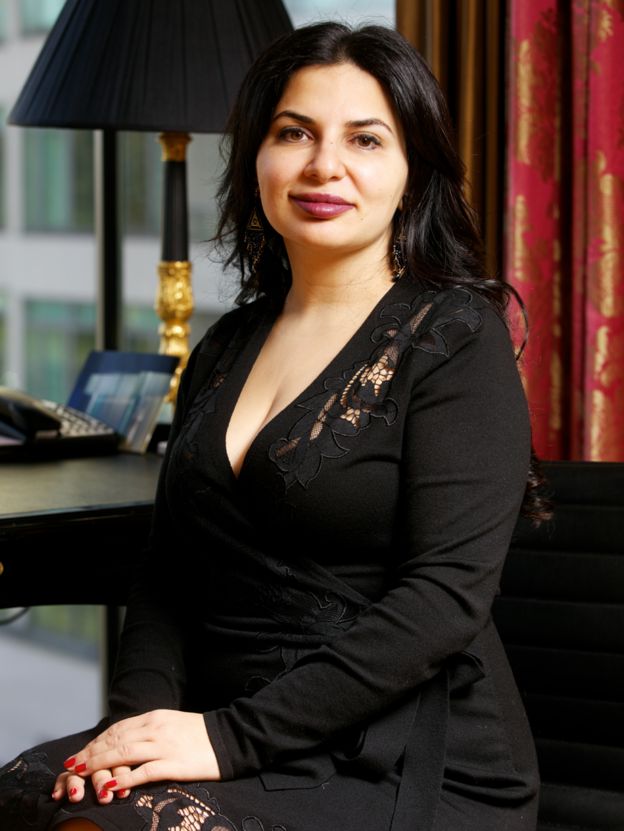

The reason so many people are excited by Bitcoin is that it solves that problem. It depends upon a special type of database called a blockchain, which is like a huge book – one that Bitcoin owners have independent but identical copies of. Every time a Bitcoin is sent from me to someone else, a record of that transaction goes into everyone’s book. Nobody – not banks, not governments, or the person who invents it – is in charge or can change it. There is some very clever maths behind all this, but this means that Bitcoins can’t be faked, they can’t be hacked and can’t be double-spent.
(I tested this explanation on my mother, the family technophobe, and she told me I’d failed to make it clear enough and should start again. So don’t worry too much if you don’t follow it either.) The key point is that these special blockchain databases are what make cryptocurrencies like Bitcoin work. For its fans this is a revolutionary new form of currency, with the potential to sideline the banks and national currencies, and provide banking for anyone with a mobile phone. And if you get in early, there’s the chance to make a fortune.
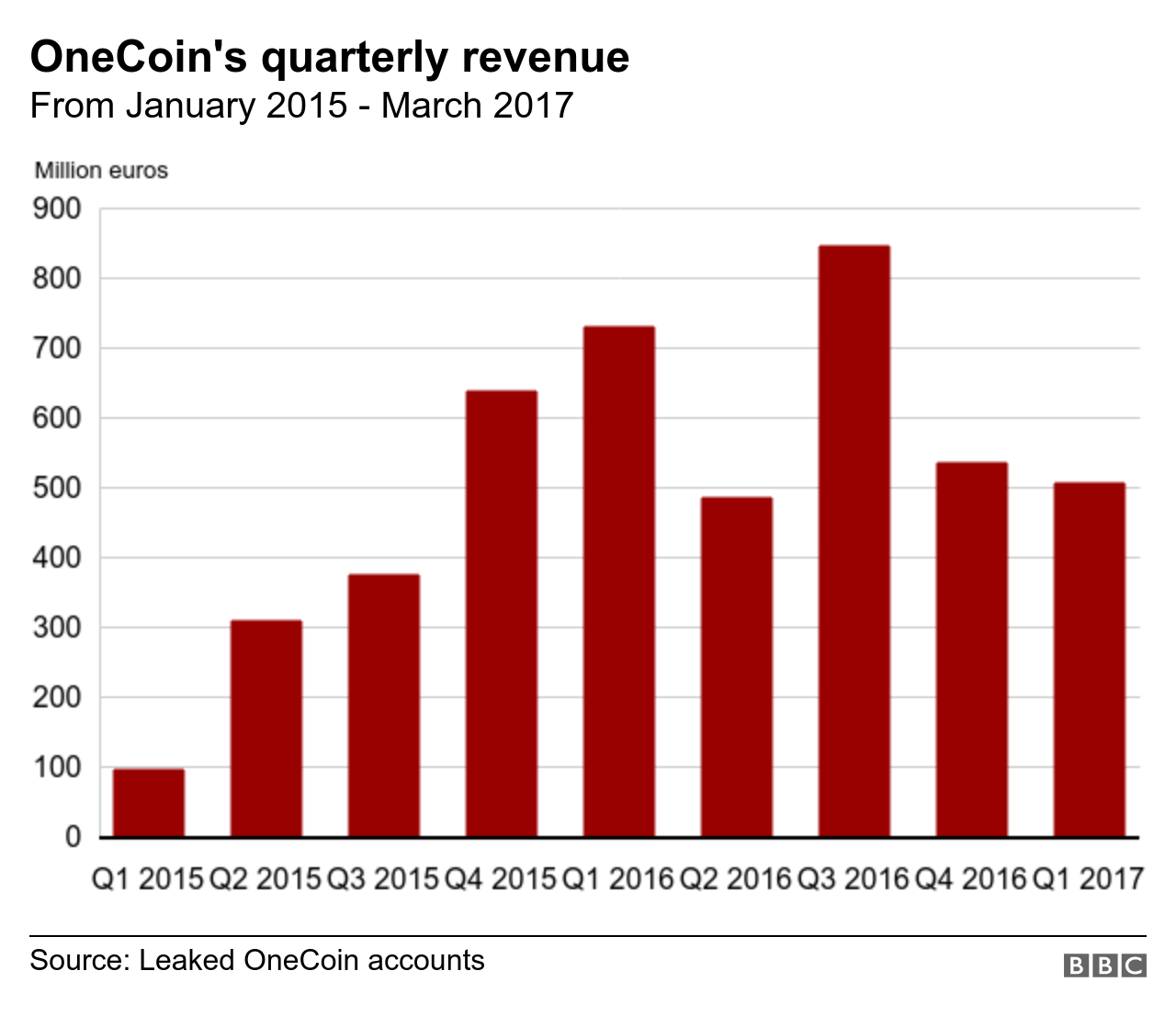
Dr Ruja’s genius was to take all of this and sell the idea to the masses.
But there was something wrong. In early October 2016 – four months after Dr Ruja’s London appearance – a blockchain expert called Bjorn Bjercke was called by a recruitment agent, with a curious job offer. A cryptocurrency start-up from Bulgaria was looking for a chief technical officer. Bjercke would get an apartment and a car – and an attractive annual salary of about £250,000.
“I was thinking: ‘What is my job going to be? What are the things that I’m going to have to do for this company?'” he recalls.
“And he said: ‘Well, first of all, they need a blockchain. They don’t have a blockchain today.’
“I said: ‘What? You told me it was a cryptocurrency company.'”
The agent replied that this was correct. It was a cryptocurrency company, and it had been running for a while – but it didn’t have a blockchain. “So we need you to build a blockchain,” he went on.
“What’s the name of the company?” asked Bjercke.
“It’s OneCoin.”
He didn’t take the job.
Jen McAdam’s ‘tycoon’ package
One spring day a few months earlier, Jen McAdam received a message from a friend about an unmissable investment opportunity. Sitting at her computer, the Glaswegian clicked on a link and joined a OneCoin webinar.
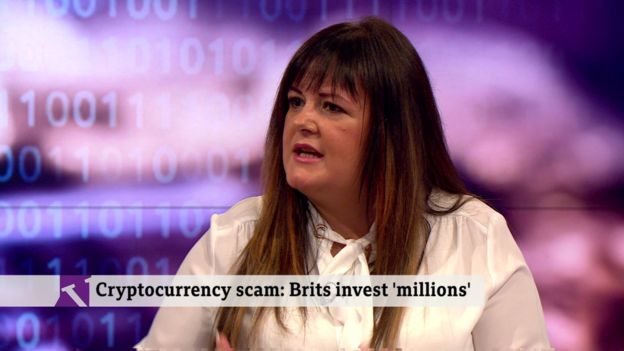
Jen McAdam on the BBC’s Victoria Derbyshire programme
Over the next hour or so she listened carefully to people talking enthusiastically about this exciting new cryptocurrency – how it could transform her fortunes. All of them were “very up-tempo, full of beans, full of passion”, she remembers. “You are so lucky that you’re seeing this webinar right now,” she was told. “You’re in at such an early stage and it’s just going to go like Bitcoin. It’s going to go bigger.”
The webinar hosts talked about Dr Ruja’s glittering background: Oxford University, a PhD from Konstanz, a stint with the respected management consultancy, McKinsey and Company… A speech Dr Ruja had given at a conference hosted by The Economist magazine was shown – and that’s what clinched it for McAdam. “That ticked a box… The power of the woman – well done! I felt proud of her.”
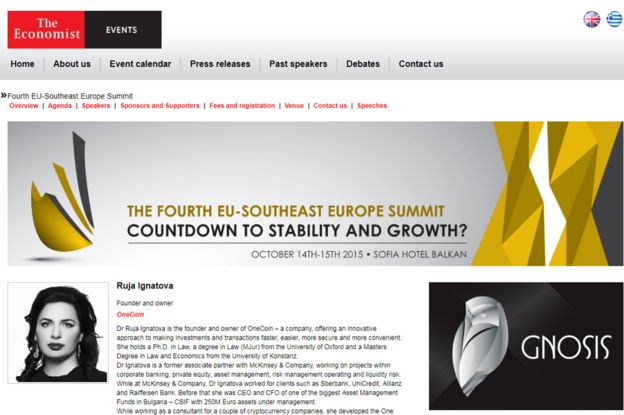
The video of Dr Ruja at the Economist conference was what clinched it for Jen McAdam
By the time the webinar had finished she had decided to invest €1,000. It was easy: you purchased OneCoin tokens, and these then generated coins, which went into your account. One day soon, she was told, she would be able to turn these coins back into euros or pounds. It seemed like easy money. Maybe €1,000 wasn’t enough? The promoters said it was the larger packages that were really life-changing. The smallest package cost €140, but they went all the way up to €118,000. One week later McAdam bought a “tycoon” package, for €5,000.
Before long, she had invested €10,000 of her own money – and persuaded friends and family to invest €250,000 of theirs. She watched excitedly on the OneCoin website as the value of her coins steadily rose. Before too long they had passed £100,000 – a 10-fold return. She started planning holidays and shopping trips.
But towards the end of the year Jen McAdam was contacted by a stranger on the internet. He claimed to be a good Samaritan, someone who had studied OneCoin carefully and wanted to speak to people who had invested. Reluctantly, she agreed to a conversation on Skype. It turned out to be a shouting match, but it would send McAdam’s life in a new direction.
The stranger was Timothy Curry, a Bitcoin enthusiast and cryptocurrency advocate. He thought OneCoin would give cryptocurrencies a bad name, and he told McAdam bluntly that it was a scam – “the biggest scam in the [expletive] world”. He said he could prove it, too. “Well then prove it to me!” she replied, sharply.
Over the next several weeks, Curry sent a stream of information about how cryptocurrencies work: links, articles, YouTube videos. He introduced her to Bjorn Bjercke, the blockchain developer who said there was no blockchain.
It took McAdam three months to go through it all, but questions were starting to form. She started asking the leaders of her OneCoin group if there was a blockchain. At first she was told it was something she didn’t need to know, but when she persisted she finally got the truth in a voicemail in April 2017.
“OK Jen… they don’t want to disclose that kind of information, just in case something goes wrong where the blockchain is being held. And plus, as an application, it doesn’t need a server behind it. So it’s our blockchain technology, a SQL server with a database.”
But by this stage, thanks to Curry and Bjercke, she knew that a standard SQL server database was no basis for a genuine cryptocurrency. The manager of the database could go in and change it at will.
“I thought, ‘What???’ And literally my legs just went, and I fell on the floor,'” she says.
The inescapable conclusion was that those rising numbers on the OneCoin website were meaningless – they were just numbers typed into a computer by a OneCoin employee. Far from putting an end to their financial worries, she and her friends and family had thrown a quarter of a million euros away.
Dr Ruja disappears
Although Jen McAdam had now seen the light, few other OneCoin investors had. Dr Ruja was still travelling the world to sell her vision – hopping from Macau to Dubai to Singapore, filling out arenas, pulling in new investors. OneCoin was still growing fast, and Dr Ruja was starting to spend her new fortune: buying multi-million-dollar properties in the Bulgarian capital, Sofia, and the Black Sea resort of Sozopol. In her downtime she would throw parties on her luxurious yacht The Davina. At one, in July 2017, the American pop star Bebe Rexha performed a private set.
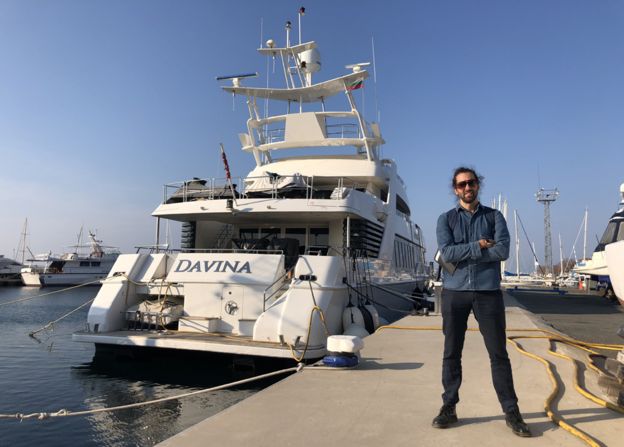
The Davina – and Jamie Bartlett
Despite the successful facade, trouble was brewing. The opening of a long-promised exchange that would allow OneCoin to be turned into cash kept being delayed – and investors were growing more and more concerned.
This was to be resolved at a large gathering of European OneCoin promoters in Lisbon, Portugal, in October 2017.
But when the day came, Dr Ruja – who was famously punctual – didn’t show up.
“She was on her way. Nobody knew why she wasn’t there,” recalls one delegate. Frantic calls and messages went unanswered. The head office in Sofia, where she was such an imposing presence, didn’t know anything either. Dr Ruja had vanished. Some feared she’d been killed or kidnapped by the banks, who – they’d been told – had most to fear from the cryptocurrency revolution.
In fact, she had gone underground. FBI records presented in court documents earlier this year indicate that on 25 October 2017, just two weeks after her Lisbon no-show, she boarded a Ryanair flight from Sofia to Athens. And then went completely off radar. That was the last time anyone saw or heard from Dr Ruja.
MLM’s most successful product
Igor Alberts is wearing black-and-gold everything. Black-and-gold shoes, black-and-gold pleated suit, black-and-gold shirt, black-and-gold sunglasses, and he has a thick black-and-gold ring on. And every item of clothing is Dolce and Gabbana.
“When you look at my clothes, they are disciplined,” he says. His wife, Andreea Cimbala, nods along, adding that if he wakes up and puts on pink underwear, he sticks to pink as he chooses his shirt, trousers and jacket.
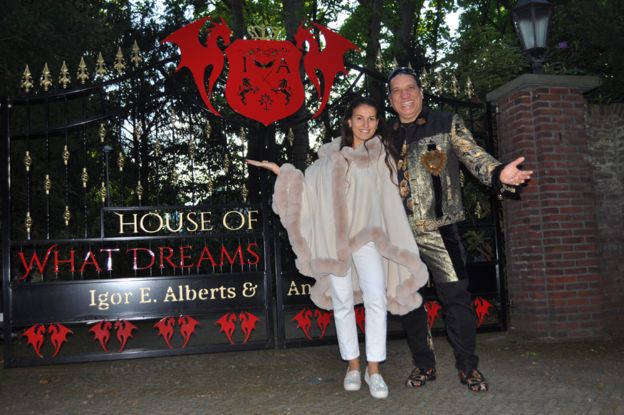
Igor Alberts and Andreea Cimbala outside their house
They live in an enormous house in an affluent neighbourhood on the outskirts of Amsterdam. At the gated entrance to their mansion is a 10ft-high wrought iron gate with their names and the slogan “What dreams may come”. A Maserati and Aston Martin are parked outside.
Alberts was brought up in a poor neighbourhood. Then he got into network marketing, or multi-level marketing (MLM) as it is often known, and started making money. Lots of money. He claims he has made €100m over the last 30 years.
Here is how multi-level marketing works.
I pay £100 to start selling vitamin tablets directly to people. I sell a box to my friends, Georgia and Phil, and make a small cut. But then I recruit Georgia and Phil to start selling too, and I make a cut on their sales as well. They are now in what’s called my downline. Phil and Georgia both recruit two people, and then all four of them recruit two more, and so on. This mushrooms very rapidly – 25 rounds of recruitment later and everyone in the UK would be selling vitamins. (And I, at the top, would be making a cut on all the sales.)
MLM is not illegal. Big companies like Amway and Herbalife use these techniques. But it is controversial, because usually only a small number of people make all the money. It’s also notorious for exaggerated promises of high earnings and tough sales targets. When there is nothing of value to sell, though, and all the money is made by recruiting other people, it is illegal and goes by another name: a pyramid scheme.
In May 2015, already a very successful MLM seller, Igor Alberts was invited to a OneCoin event in Dubai, where he met lots of people, all apparently making fortunes with this new currency. Dr Ruja herself made a powerful impression too, with her “princess’s dresses” and her vision of a financial revolution. Igor returned with a new mission – and gave new instructions to all the salespeople in his downline: stop whatever you’re doing, and start selling OneCoin. “We gathered the teams together and we started to work like crazy,” he says. “We made in our first month almost €90,000 out of nothing. Bang!”
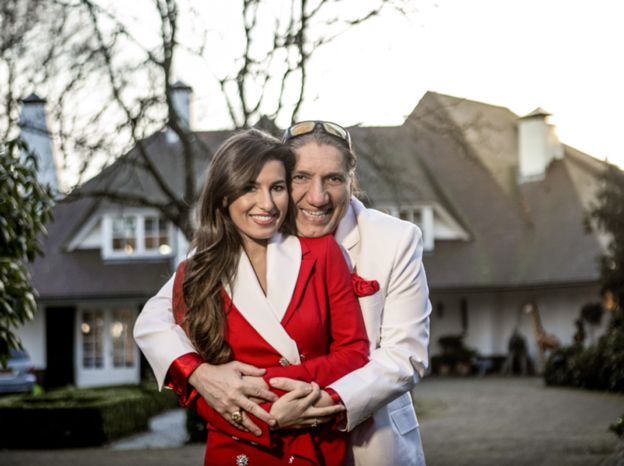
Andreea Cimbala and Igor Alberts
Dr Ruja’s genius was to recognise that established MLM sellers with huge downlines were the perfect vehicle to market her fake coin – a plan the FBI says she privately referred to as “the bitch of Wall Street, meets MLM”. This was the secret of OneCoin’s success. It wasn’t just a fake cryptocurrency, it was an old-fashioned pyramid scheme, with the fake coin as its “product”. No wonder it spread like wildfire.
Fairly soon Igor Alberts was making more than €1m a month from OneCoin, which quickly became the biggest product in network marketing. “No other company even came close,” Alberts says.
Sixty per cent of the income Igor Alberts and Andreea Cimbala made from OneCoin (in the end, more than €2m per month) was paid in cash, the rest in OneCoin. But they used some of this cash to buy more OneCoin. They, like almost everyone else involved, were convinced they were earning a fortune.
“I did the calculation how many coins we needed to become the richest person on the planet,” Igor says. “I said to Andreea, ‘We need to build it up to 100 million coins, because when this coin goes to €100 and we have 100 million, we are richer than Bill Gates.’ It’s mathematic. It’s easy as that.”

Andreea Cimbala and Igor Alberts
The nature of MLM networks – where people often recruit others who are close to them – creates a blurred sense of responsibility. Blame is not easy to apportion. And if sellers have invested their own money, they are victims too.
After Dr Ruja’s non-appearance in Lisbon, a point came when Igor Alberts, like Jen McAdam, asked to see evidence of the blockchain. He didn’t get it, and in December 2017 he quit.
I ask if he felt guilty, for having sold so many people a coin that didn’t exist, and for having made so much money in the process.
“I felt responsibility. Not guilt,” he replies. “You can never be blamed for believing in something. I had no clue that it could be false. I didn’t even know what is a blockchain… What doubt can I have?”
He points out that he spent millions buying OneCoin, possibly more than anyone else.
By contrast, Jen McAdam says she bears a heavy burden of guilt. I ask her how much she earned from selling OneCoin and she says it was €3,000 – €1,800 of which she received in cash, and which she used to buy more OneCoin.
She feels guilty towards those who she introduced to OneCoin, she says, but also towards her late father, a miner, who worked hard all his life in horrible conditions, and left her the money that she then gave away.
Following the money
It’s hard to know how much money has been put into OneCoin. Documents leaked to the BBC say €4bn between August 2014 and March 2017. I’ve also been told by more than one person that it could be as much as €15bn.
There’s a famous saying in journalism, “Follow the money.” So with Georgia Catt, producer of The Missing Cryptoqueen podcast, I went to see Oliver Bullough, an expert on what he calls Moneyland – the shadowy parallel world where criminals and the super-rich hide their wealth. The problem, he explains, is that following the money isn’t as easy as it sounds, because criminals structure their companies and bank accounts in such a way that their assets seem to disappear. “They still exist”, he says, in his garden near the village of Hay-on-Wye. “You can still use them to buy things, you can still use them to buy political influence and nice houses and yachts. But when it comes to someone trying to find them – whether that’s a journalist or a police officer – they are invisible.”
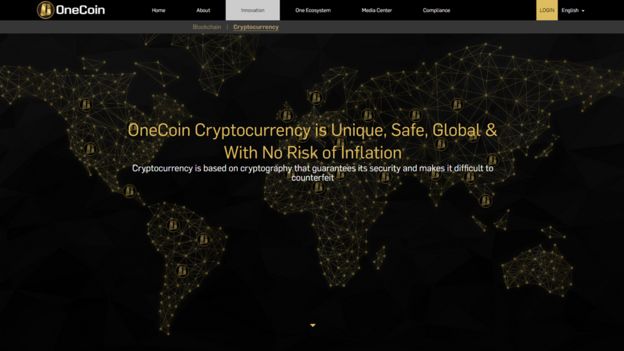
A page on the OneCoin website
It’s no surprise, then, that OneCoin’s corporate structure is incredibly complicated. Here’s an example: Ruja bought a very large property in central Sofia. Technically it was owned by a company called One Property. One Property was owned by another company called Risk Ltd. Risk Ltd was owned by Ruja, but was then transferred to some unnamed Panamanians, but it was still managed by another company called Peragon. And Peragon was owned by another company called Artefix, which was owned by Ruja’s mother, Veska. And then in 2017, the ownership of Artefix was sold to an unknown man in his 20s.
Oliver describes this kind of dizzying arrangement as “improbably standard”.
For several months, a French journalist called Maxime Grimbert tried to unpick OneCoin’s corporate workings, collecting as many company names and bank account details as he could. I show his results to Bullough, who immediately notices how many British companies there are. “British companies are the companies of choice,” he comments. “They’re very easy to set up and they look legitimate.”
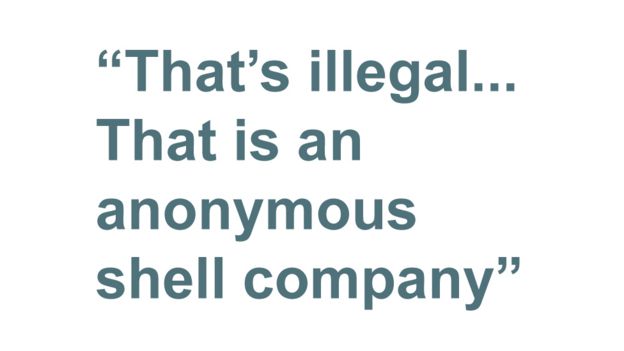
He takes the first one on the list and looks it up on the Companies House website. Everything is meant to be transparent – the website contains the details of every company in the UK. It’s thought to be a key anti-corruption tool. “We are very proud of this in this country,” he says. “The problem is that when you create this company, no-one checks any of the information provided.” He clicks to see the company’s filing history, but where you should see company accounts, there is nothing. “This is classic,” he exclaims. “Look, nothing has happened. They have filed no financial information at all.” Then he tries checking the company’s owners. The UK began to insist recently that companies must enter the name of the person with “significant control” – the real owner.
“This is supposed to mean that you can no longer use a British company to hide behind,” he says, as he scrolls down the page. “Oh, hey presto, they haven’t filed a person with significant control. That’s illegal… That is an anonymous shell company, as anonymous as anything that you can buy anywhere in the Seychelles or Nevis or the Marshall Islands or Vanuatu.”
So much for following the money. In an interconnected global economy, assets can simply vanish, and you end up chasing shadows.
When you’re dealing with a scam worth billions of euros, it’s not unusual for shadowy groups to get involved. Several of the people Georgia and I interviewed spoke darkly about mysterious people and connections they didn’t want to name.
“When you talk about the amount of money that’s been put into OneCoin of course there’s people out there who are pissed off and would do anything to shut anyone like me up,” says Bjorn Bjercke, the blockchain expert who discovered there was no blockchain, and started talking about it publicly.
He tells me he’s received death threats as a result of speaking out. “If I knew what I would have to go through, I would have never blown the whistle. I would have just turned my back and walked away,” he says.
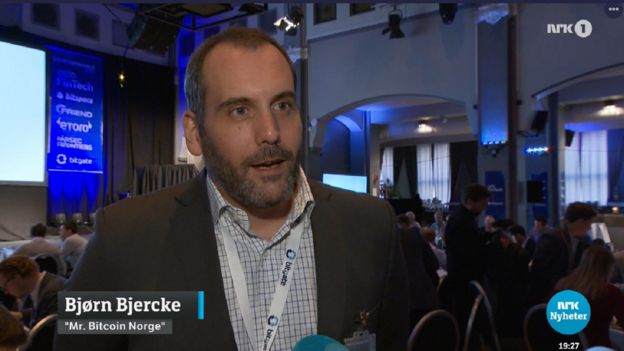
Bjorn Bjercke on Norwegian television
When I ask him who might be behind the threats, he won’t elaborate. “I can’t discuss that. It starts to get very very very scary, very very very fast.” According to Bjercke, Dr Ruja never expected OneCoin to grow so big. People involved at the early stages have told him it was never supposed to be a billion-dollar scam. She tried to close it down, he says, but the dark forces wouldn’t let her.
“Once OneCoin was running above 10 million, 20 million, 30 million, something happened where she was unable to stop it,” Bjercke says.
“I think she was so scared in the fall of 2017 that she decided to skip.”
Igor Alberts, the MLM seller, also talks about the involvement of “very influential people”.
When I ask for more details, he replies: “No, I cannot tell that because I don’t want to take that risk with our lives.”
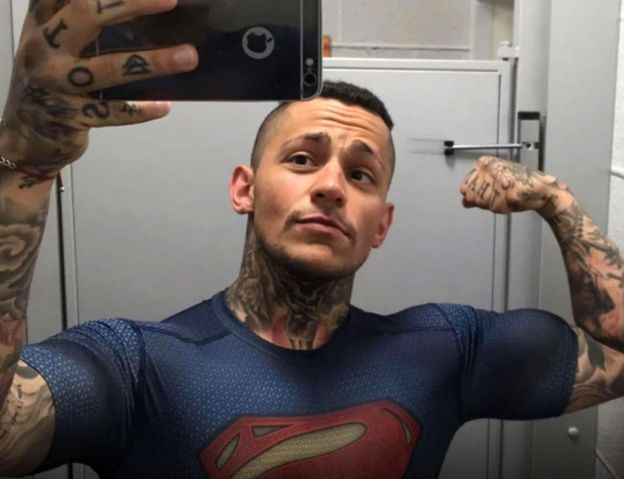
Konstantin Ignatov
It’s not clear who Bjorn and Igor are talking about, or whether they are even talking about the same people, but the US Department of Justice claims to have evidence of a link between Dr Ruja’s brother, Konstantin Ignatov – who took over the running of OneCoin when Ruja disappeared – and “significant players in Eastern European organised crime”.
Inside ‘the family’
On 6 March 2019 Konstantin Ignatov was at Los Angeles International airport, waiting to fly back to Bulgaria after some OneCoin meetings in the US. Just as he was boarding his flight home, he was pounced on by FBI agents, arrested ,and charged with fraud in connection with OneCoin. Around the same time, the US authorities charged Dr Ruja in absentia for wire fraud, security fraud and money laundering.
Amazingly, even after this, OneCoin continued to function – and people continued to invest in it. When Georgia and I visited Sofia a month later, Dr Ruja’s personal mansion appeared to be locked up and empty, but the OneCoin office gave every appearance of being a busy workplace.
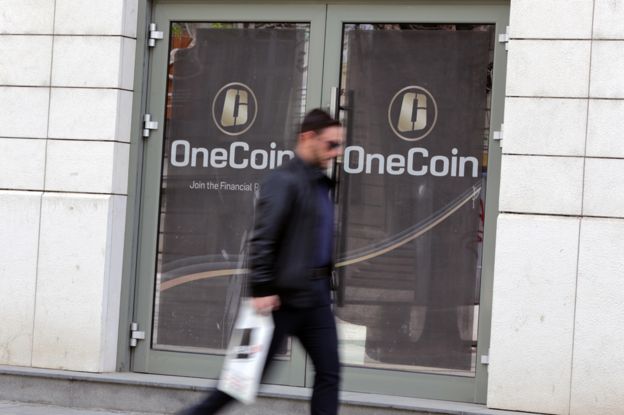
OneCoin headquarters in Sofia, Bulgaria
Why have so many people continued to believe in OneCoin, despite all the evidence?
Investors often told us that what drew them in initially was the fear that they would miss out on the next big thing. They’d read, with envy, the stories of people striking gold with Bitcoin and thought OneCoin was a second chance. Many were struck by the personality and persuasiveness of the “visionary” Dr Ruja. Investors might not have understood the technology, but they could see her talking to huge audiences, or at the Economist conference. They were shown photographs of her numerous degrees, and copies of Forbes magazine with her portrait on the front cover.
The degrees are genuine. The Forbes cover isn’t: it was actually an inside cover – a paid-for advertisement – from Forbes Bulgaria, but once the real cover was ripped off, it looked impressive.
But it seems it’s not just the promise of riches that keeps people believing. After Jen McAdam invested into OneCoin she was constantly told she was part of the OneCoin “family”. She was entered into a Whatsapp group, with its own “leader” who disseminated information from the headquarters in Sofia. And McAdam’s leader prepared her carefully for conversations with OneCoin sceptics. “You’re told not to believe anything from the ‘outside world’,” she recalls. “That’s what they call it. ‘Haters’ – Bitcoiners are ‘haters’. Even Google – ‘Don’t listen to Google!'” Any criticism or awkward questions were actively discouraged. “If you have any negativity you should not be in this group,” she was told.
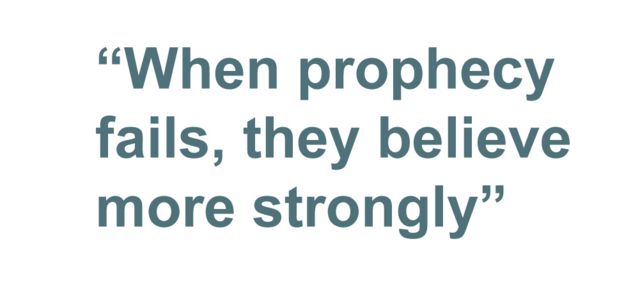
Prof Eileen Barker of the London School of Economics, who has spent years studying groups like the Moonies and Scientologists, says there are similarities between OneCoin and messianic millennium cults, where people believe they are part of something big that is going to change the world – and no matter what the evidence, once they’ve signed up, it’s very hard for them to admit they are wrong.
“When prophecy fails they believe more strongly,” she says. “Particularly if you have invested something, not only money, but belief, reputation, intelligence. You think, ‘Wait a bit longer.'”
Money might push people to invest in the first place, but the sense of belonging, of doing something, of achieving something, is why they stay, Barker says. “And in that sense it’s cultic.”
In an ideal world, regulators would take action to protect consumers from scams like OneCoin. But the authorities all over the world have been slow to react, partly because the whole area of cryptocurrencies is relatively new.
The UK’s Financial Conduct Authority (FCA), which is responsible for regulating financial markets in the UK, issued a warning on its website only in September 2016. “We believe consumers should be wary of dealing with OneCoin,” it said. “We are concerned about the potential risk this poses to UK consumers.”
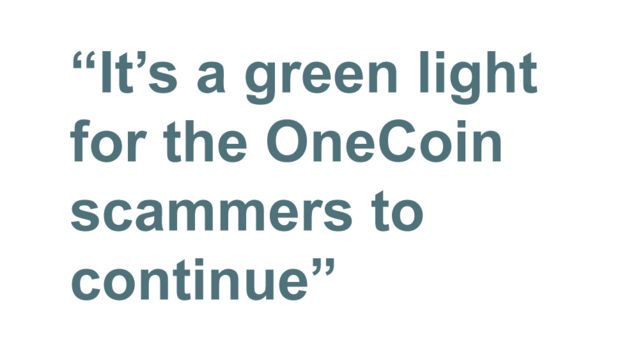
Less than a year later, the warning was removed from the website. The FCA said it had been up for long enough, but OneCoin promoters presented this as proof that the UK authorities considered OneCoin a legitimate investment.
“There’s the answer, right from the horse’s mouth, it’s official,” said one promoter from Alberta, Canada, in a video posted online. “If they still thought we were a fraudulent company, then guess what, that warning’s not removed. Game over.”
Several OneCoin events took place in the UK after the FCA took down the warning, and money continued to be invested. The FCA did not respond to the BBC’s request to comment.
The fact that OneCoin was operating internationally also created difficulties for the authorities. In August this year, the City of London police ended a two-year investigation into OneCoin. “The companies and individuals behind OneCoin are based outside UK jurisdiction,” it said. “We’ve been unable to identify UK-based assets, which could be used to compensate UK investors.”
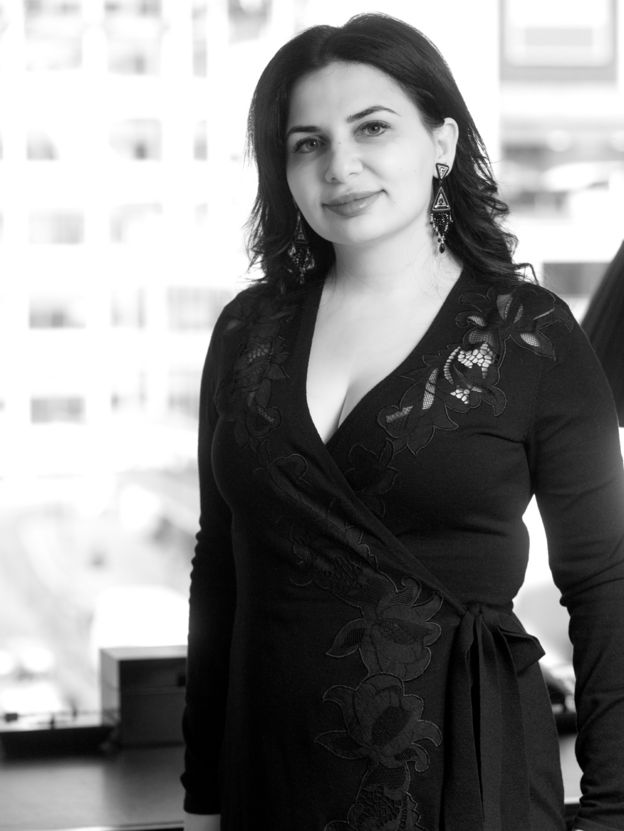

Such explanations don’t offer much comfort to those affected. “I’m devastated for all the UK victims,” Jen McAdam told me, when she heard the news. She now runs Whatsapp support groups for OneCoin investors who realise they have been swindled. “Where’s the support? Where’s the help? More folk are going to promote this. It’s a green light for the OneCoin scammers to continue and extort more money from innocent people in the UK and nothing has been done about it. They don’t care!”
The City of London Police told the BBC: “There was insufficient evidence to support criminal proceedings against individuals based in the UK, though the force has never specified that there had been no concerns surrounding OneCoin. The force has provided assistance to foreign law enforcement partners in respect of their investigations concerning OneCoin personnel and will continue to do this. If you believe you have been a victim of fraud in relation to OneCoin or you suspect someone of actively marketing OneCoin, please come forward and report it to Action Fraud online.”
Until this week, however, the OneCoin head office remained open for business – and people were continuing to promote the currency.

Today doors are locked. No lights visible through the windows.
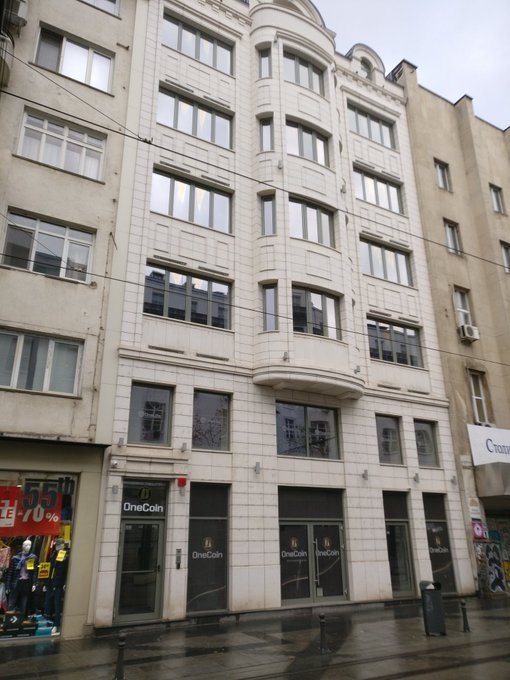
362:29 PM – Nov 20, 2019Twitter Ads info and privacySee ᑎIᑕKOᒪᗩY ᔕTOYᗩᑎOᐯ’s other Tweets
A Ugandan tragedy
In the Ntangamo region of Uganda, not far from Rwandan border, most people make their living growing bananas, or sometimes cassava, sweet potato, beans or groundnut. In 2016 it was here that 22-year-old Daniel Lienhardt came as he was scraping together the 700,000 Ugandan shillings ($250) he needed to buy a OneCoin starter package.
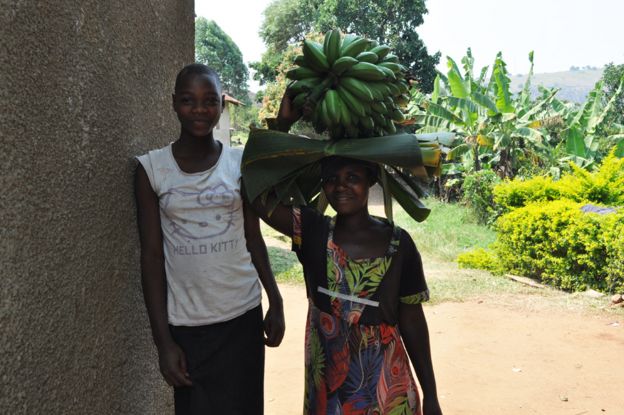
He already had 400,000 shillings in savings, and to raise the rest he returned from the capital, Kampala, to his family home, took three goats raised by his younger brothers, and sold them.
“There was no other way,” he says ruefully.
Daniel is one of thousands of Ugandans who’ve bought into Dr Ruja’s fake cryptocurrency – and the OneCoin financial documents leaked to the BBC reveal that as time went on, investors like him became increasingly important to OneCoin.
In Europe, less money was invested in the first six months of 2017 compared to the same period in 2016. But in Africa, the Middle East and the Indian subcontinent, it was the other way round. As the money started drying up in Europe, promoters turned more and more to countries like Uganda.
Daniel took me and Georgia to meet Prudence, who first introduced him to OneCoin. They are still friends, even though both now realise it’s a scam.
Prudence is a nurse in a Kampala slum, who thought she could make more money selling OneCoin and set about recruiting new investors. A senior promoter gave her a nice car to impress customers, and instructed her to visit farmers when their crops were being harvested and they had money in their pocket.
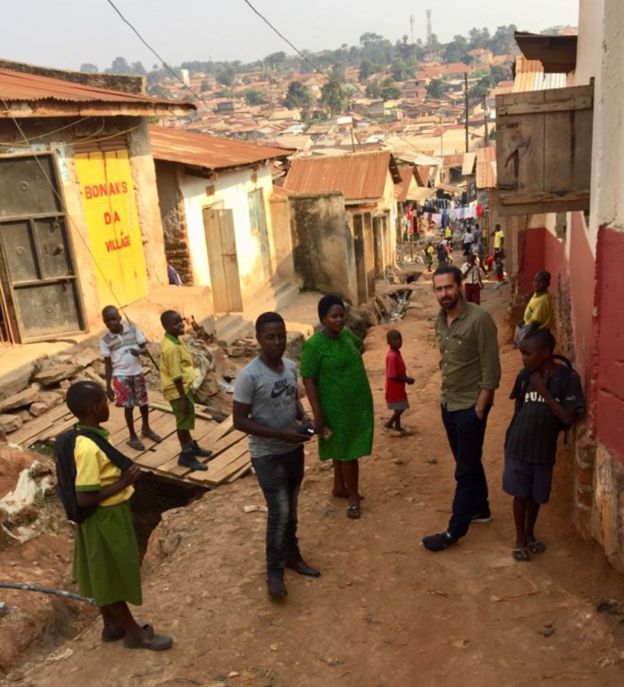
Daniel, Prudence and Jamie with children in the poor area of Kampala where Prudence works as a nurse
People in villages trust people from the city, Prudence tells us. To buy the packages some sold their cattle, their land and even their houses – with disastrous consequences.
“Some of their kids are at home sitting without going to school – some don’t have anywhere to sleep. Some are running because they got loans from a bank. Some are hiding. Some are divorced.”
If anyone asks Prudence when the investment is going to deliver the promised riches, she tells them to wait. She can’t bring herself to tell them the truth.
“I’m somehow hiding myself. I don’t want those people I introduced into OneCoin to see me moving around. They can easily kill me. They thought I ate their money.”
But though she has stopped recruiting, many others haven’t, and there are still plenty of interested buyers, she says.
One of the main OneCoin offices in Kampala is attached to a church. There are videos of the minister, known as Bishop Fred, leading the congregation in call and response. “One Life!” he shouts. “One Coin!” the congregations replies. Bishop Fred, we learned, is now one of the country’s top promoters of OneCoin, though he says it’s no longer promoted during church services.
As in other countries, OneCoin has spread here through networks of friends and families. Together with Daniel, Georgia and I travel south to meet his mother. She lives in a concrete house with a tin roof – five small rooms, a small television and a cooking area. A towel covers the front door, and a few metres away is her land, where she grows her own food and sells anything left over at the local market.
The family had saved about £3,000 to buy a maize store so that Daniel’s mother could stop spending every day in the fields. But when Daniel found out about OneCoin, it suddenly seemed like a much better alternative. His mother had doubts, but he persuaded her to put the money into OneCoin instead. She had no computer or smartphone, to do her own research.
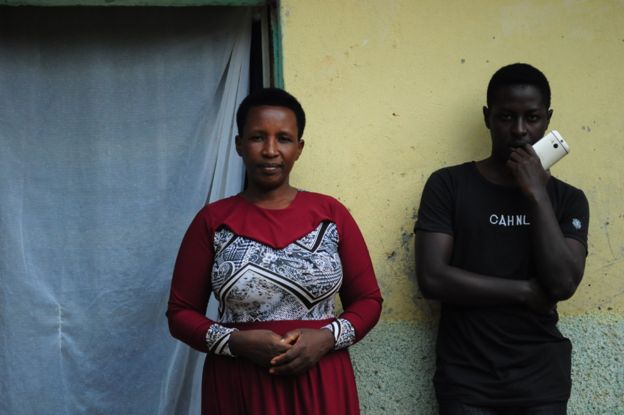
Daniel and his mother
She doesn’t speak English either, so I’m shocked to discover, as we sit and talk, that Daniel has never actually told his mother that the money is lost.
“I’ve never told her directly that it’s not going to work – that there is no more money, there’s no more hope,” he tells me. “I’ve been telling her it’s changing. They keep postponing this. That I don’t know what they’re thinking. Maybe it’s just a delay. I haven’t given her 100% full confirmation that it won’t work.”
I ask him why not. “It’s hard. It’s hard to say.”
Daniel’s mother then tells us that when she first saw me and Georgia, she assumed it was a good sign – that perhaps it meant that her money was going to arrive at last. She asks what news we have about OneCoin. Will she get her money back?
I look at Daniel.
“Maybe you can tell her… Maybe…” he says.
He doesn’t seem certain it’s a good idea. Perhaps it would put him in an uncomfortable position. I don’t want to be the person that breaks the news to Daniel’s mother.
Georgia suggests we tell Daniel’s mother that we are journalists, and that we are investigating OneCoin because a lot of people aren’t getting their money.
Daniel translates, and his mother’s reply comes back.
“If you have your money and it’s taken away from you, life becomes stressful,” she says. “You’ve been planning, planning for something. If it doesn’t happen, life is hard.”
Where are you, Dr Ruja?
When we started planning the Missing Cryptoqueen podcast in late 2018, no-one really had a clue what happened to Dr Ruja after her disappearance. It was only earlier this year that the US authorities revealed she’d flown to Athens on 25 October 2017. And even then, the question remained, where had she gone next?
There were rumours of course – lots of them. Igor Alberts, the MLM kingpin, said he’d heard she has Russian and Ukrainian passports and travels back and forth between Russia and Dubai. It’s also been suggested that there are powerful people who might protect her in her native Bulgaria – and that she could hide in plain sight because of plastic surgery that makes her unrecognisable. I’ve even heard that she might be in London. Others told us she was dead – which does remain a possibility.
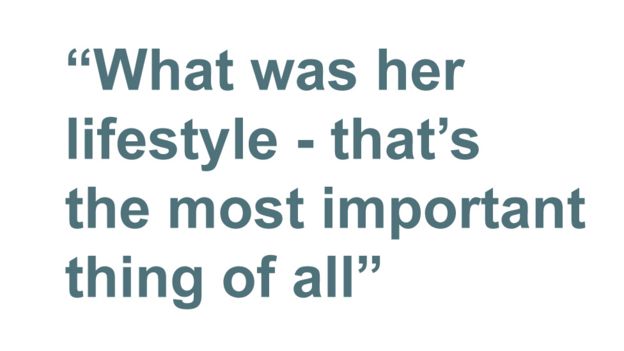
This is clearly a question for a professional, which is why Georgia and I went to see private investigator Alan McLean. Finding people is his speciality, and there is one thing above all he says we should focus on.
“What was her lifestyle? That’s the most important thing of all,” he says. “Go back to her life before OneCoin. Find out who her friends were, what her lifestyle was like, her family.”
Another tip he gives us is to find out where she has been on her yacht. We should try to get the tracker off it, he says, and he doesn’t appear to be joking. I explain that this is probably beyond my abilities (apart from being illegal). Then he says I should check what yachts were bought in Athens around the time she arrived there from Sofia.
“In my opinion, for what it’s worth, she’s moving around the Mediterranean,” he says.
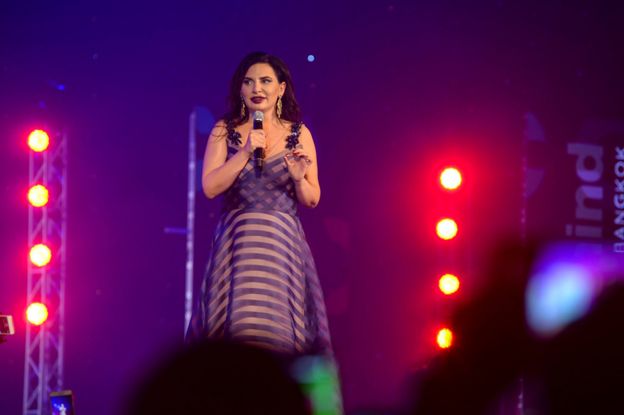
Dr Ruja was renowned for expensive dresses and red lipstick
A few weeks after our meeting Alan gets back in touch, with some amazing information. His colleagues – also private investigators – visited top-end restaurants in Athens armed with photos of Ruja, and in one of them several waiters claimed to clearly remember her dining there earlier this year. When Georgia and I called them ourselves to check, they confirmed it. So it seems Ruja is still alive, and is able to visit a European capital without fearing arrest.
Another lead comes our way when we pay a visit to a bizarre OneCoin beauty pageant in Bucharest. It’s as glitzy as you would expect. Men are drinking champagne from the bottle, everyone is eyeing us in a way that makes us feel very uncomfortable. We soak up the atmosphere, cheer the British contestant, and then leave. But later we hear that we might have been in the presence of Dr Ruja – that she was there, in the same room, right in front of our noses. Except now with plastic surgery, and so harder to spot.
From either Greece or Romania Dr Ruja could be extradited to the US. If it’s true she was in these countries earlier this year, she probably has a fake identity.
Taking seriously Alan McLean’s advice about studying Dr Ruja’s life before OneCoin, Georgia and I turn to the internet, which fortunately never forgets anything.

Even the most obscure entry or innocuous comment on a forum is usually saved somewhere, and with enough digging can be found. You’ve heard of Google, but there are several other search engines that specialise in this. So we start unearthing previous addresses, known friends, old phone numbers, anything that could help us.
We already knew that Dr Ruja spent some of her childhood in Schramberg, southern Germany. We had also visited the town of Waltenhofen in Bavaria, not far away, where she and her father bought a steelworks around a decade ago, an episode that led to her being tried for fraud. (She received a fine and a suspended sentence in October 2016.) While in Waltenhofen, we learned that she had a German husband, a lawyer for the well-known firm, Linklaters.
But we were still surprised when, during our internet searches, Frankfurt started appearing over and over again. It wasn’t a place we’d previously thought of looking.
There were several old addresses in the Frankfurt area – ones she’d posted in forums many years ago, or were associated somehow with old phone numbers of hers. Then we started looking at some old photos of Ruja, and spotted one friend who appeared with her all the way back to 2011. And that friend was visiting the richest neighbourhood in Frankfurt in summer this year. From a tiny fragment of a poster advertising a tennis tournament, an expert identified the park in which one photograph was taken.
We also learned that Dr Ruja had a daughter in late 2016, and that she remained very close to her. The daughter, we were informed, might be in Frankfurt. This is also where Dr Ruja’s husband – or perhaps ex-husband – lives and works.
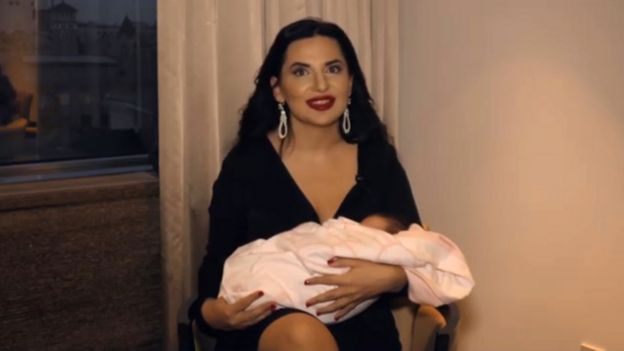
Dr Ruja posted a video of herself with her baby on social media
Armed with a microphone and several photographs of Dr Ruja, we headed off to Frankfurt and searched old addresses and gated neighbourhoods said to be the most expensive in Germany. A couple of people looked at the photographs and paused for a long time, raising our hopes – but then said they didn’t recognise her. A postman thought he recognised the name, but couldn’t be sure. We called the lawyer who is (or was) married to her, and he didn’t want to talk.
Did we get close to her? Could she really be hiding out in the heart of the EU? We don’t know. Frankfurt probably isn’t the only place she goes – it might be one of several places, including perhaps Dubai and Russia.
Then a few days later we received a call from a trusted source we cannot identify. He told us we were right – Frankfurt is indeed where she spends much of her time. But we need to keep going, we needed to find the house. “You will find her,” he said. “You must dig deeper.”
She would have known that we were looking for her, he added, and she would have laughed at us.
On 5 November 2019, the day after the final episode of The Missing Cryptoqueen podcast was released, Dr Ruja’s brother, Konstantin Ignatov, appeared in court in New York, testifying for the government in a case against a lawyer accused of laundering $400m of the money OneCoin made in the US.
In court it was revealed that Ignatov signed a plea deal on 4 October, in which he pleaded guilty to several fraud charges. A court reporter was there to hear his testimony, and according to his account of the proceedings Ignatov appears to have implied that his sister had duped him with the same line the organisation put out to its investors – that OneCoin critics were “haters” who could not be believed.
She vanished, he said, because she was afraid that somebody close to her was going to give her up to the FBI. She had got hold of a “big passport”, he said, and asked him to get her plane tickets to Vienna, then Athens.
OneCoin has always denied wrongdoing. It told the BBC: “OneCoin verifiably fulfils all criteria of the definition of a crypto-currency.” It said the Missing Cryptoqueen podcast “will not present any truthful information and cannot be considered objective, nor unbiased”. It added that the allegations made about it around the world were being challenged, stating: “Our partners, our customers and our lawyers are fighting successfully against this action around the globe and we are sure that the vision of a new system on the basis of a ‘financial revolution’ will be established.”

Some action at the OneCoin HQ at last. Doors opened. A small beaten down van parked in front and was filled with various office equipment and supplies. Didn’t seem to be the contents of the famous 3rd floor cash room 🙂 Looked as if the company is moving out, but who knows…

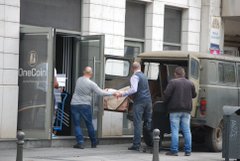

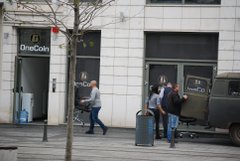
5012:40 PM – Nov 21, 2019Twitter Ads info and privacy28 people are talking about this
OneCoin was a familiar scam with a digital twist – a new and hugely successful take on the old pyramid scheme.
But to me it symbolises something else too.
It represents the dark side of rapid technological change – the way that every new technology creates amazing new opportunities and possibilities for people who understand it, but also the chance to exploit the people who don’t.

Dr Ruja comes on stage at Wembley to the song This Girl Is On Fire
Dr Ruja identified several of society’s weak spots and exploited them. She knew there would be enough people either desperate enough, or greedy enough, or confused enough to take a bet on OneCoin. She understood that truth and lies are getting harder to tell apart when there is so much contradictory information online. She spotted that society’s defence against OneCoin – the law-makers, the police, and also us in the media would struggle to understand what was happening.
And, most frustratingly of all, she correctly guessed that by the time we realised it, she’d be gone, along with the money.

